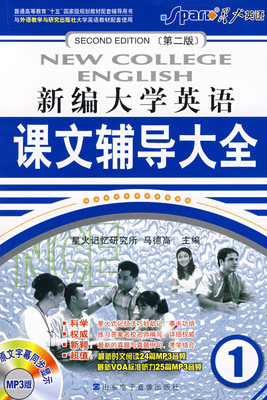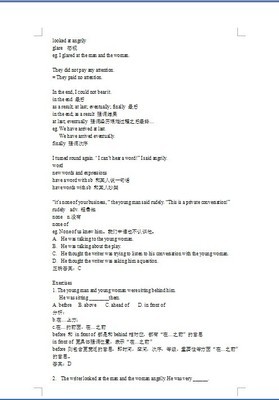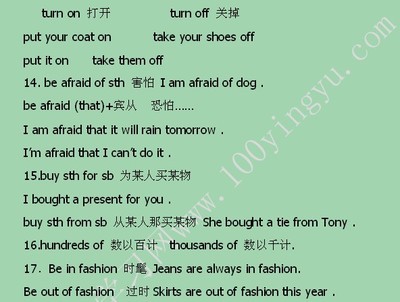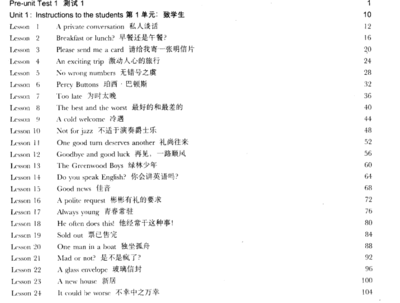Lesson1 一般疑问句的变法
1. Be 动词的用法:Be妈妈的三个儿子分别是am, is, are.
2. 用法口诀:我用am, 你用are, is跟着他她它,复数全部都用are.
eg: I am ateacher. You are a student. He is a boy.
She is agirl. It is a cat. We are students.
3. 一般疑问句定义:
⑴用yes或no回答的问句;
⑵以系动词(助动词, 情态动词)开头的问句(近期只学Be动词开头).
⑶译为 “……吗?” 的问句。
eg: Are you astudent? Is he a boy?
4. 由肯定句变一般疑问句:
口诀:找到be动词,直接提句首,人称做变化,问号别忘了。(I → you, my → your)
eg:⑴I am a teacher. → Are you a teacher?
⑵ This is mybook. → Is this your book?
5. 多学一手:He is ayes-man. 一个唯唯诺诺的人。
Lesson3 否定句的变法
1. 1—20的基数词 必须会背写。
one two three four five six seven eight nine ten eleven twelve thirteen fourteen fifteen sixteen seventeen eighteen nineteen twenty
2. 肯定句变否定句:
口诀:找到be动词,后面加not.
eg:This is a book. → This is not a book. I am a teacher. →I am not a teacher.
缩写:is not=isn’t /'iznt/ are not=aren’t /a:nt/
注意: 简约回答的肯定式不能用缩写,如:Yes, I am / he is / they are 等。
Lesson 5
1. 询问国籍: He is Chinese.(对画线部分提问) → What nationality is he?
2. 介绍两个陌生人互相认识,只能用This is + 姓名。 eg: This is Li Ming.
3. 选择疑问句:(副课语法)
结构:一般疑问句+or+一般疑问句(后句中与前句相同部分常被省略)+?
助动词+主语+(…)+选择项A+选择项B+?
语调:前句读升调, 后句读降调.
回答:不用yes或no,而用完整句子回答,有时为简约,也可直接说出选择项作为回答。 eg: Is she Chinese or Japanese? She is Chinese.
4. 何时用a或an?
口诀:不见原因(元音音素)不施恩(n),见了原因就施恩(n)。 eg: a book an apple
Lesson 7 特殊疑问句
1. 定义:就句中某部分提问的句子,就叫特殊疑问句。
2. 构成:特殊疑问词+一般疑问句+ ?
它与一般疑问句的区别:特殊疑问句不能用yes或no回答。
3. 练习:⑴ He is a worker. (对画线部分提问)
→ ①What’s his job? ②What is he?
⑵ He is Japanese. (对画线部分提问) → What nationality is he?
Lesson9 形容词
1. 记住下列反义词:fat—thin; tall—short; dirty—clean; hot—cold; old—young;busy—lazy
2. 形容词的基本用法
⑴ 作“表语” eg: ①He is fat. ②Thatpoliceman is tall.
⑵ 作“定语” eg: ①He is a fat boy. ②That is a tallpoliceman.
3. 多学一手: ①I’m in hot water. 有麻烦了。 ②He’s a cold fish. 冷酷无情的人。
Lesson 11
1. whose 的用法: ⑴作“定语” ⑵对所有格提问
eg: ⑴ Whose bookis this? (whose作book的定语)
⑵ This is mybook. (对画线部分提问)
①Whose bookis this?=②Whose is this book?
2. 所有格 “…(某人)的某物”
⑴ adj.性物主代词表示 “…的” eg:my book 我的书
⑵ 名词所有格是在名词后+’s 表示“…的”
eg: ① 直接+’s eg: 玛利的书 Mary’sbook
②以-s结尾的复数+’ eg: Teachers’Day
③两人共用之物则只在后一个+’s eg: Lucy and Lily’s room
④两人不共用时, 在两个后均加’s eg: Lucy’sand Lily’s rooms
3.所有物+of+所有者, 表示“无生命之物的所有格”。 eg: the door of the room
4.多学一手:
⑴ You look blue. 看起来筋疲力尽。 ⑵ the White House 白宫
⑶ It’s goodto tell a white lie 善意的谎言
Lesson13
对颜色进行提问用“What color”:
eg: My coat is green. What color is your coat?
Lesson15
名词变复数(一)
可数名词(c.)
n.
不可数名词(uc.)
名词变复数规则:
名词分类
规 则
例词
一般名词
直接+s
desk—desks book—books
以-s、-x、-ch
-sh结尾的
直接+es
bus—buses box—boxes
dish----dishes watch----watches
只有stomach-----stomachs(胃)
以 f或fe结尾的
变f或fe为ves
一个小偷(thief)的妻子(wife)拿着一把树叶(leaf)的形的小刀(knife)结束了一只在书架上(shelf)上偷吃半片(half)面包(loaf)的狼的生命(life)
辅音字母+o 结尾
有生命的+--es
无生命的+--s
黑人(negro)英雄(hero)爱吃土豆( potato)西红柿(tomato)
辅音字母+y结尾
变y为i加es
story---stories fly---flies family---families baby---babies
名词变复数发音: 口诀: 声----对---声 气---对----气
声: 元音因素、浊辅音
气: 清辅音
1. / p、k /+ s -----------desks maps caps books
2./ s / 、/ z / 、/ ∫ / 、/з/ 、/ t∫ / 、/ dз/ +es ----------/ iz / eg: cases
3. / t / + / s /---------/ ts / / d / + / z /----------/ dz /
4. 浊辅音、元音+ s --------/ z / eg: pens rulers dogs
Lesson17 名词变复数(二)
1. 变内部元音 tooth-------teeth foot-------feet goose------geese
man-------men woman--------women
2. 形式不变: sheep dear fish Chinese Japanese
3. “boy 、girl ”由这两个词组成的复合名词,只变后者“two boy friends”
4. “man、woman” 由这两个词组成的复合名词,前后都变
eg: a woman doctor two women doctors
5. 表人名地名的词后面直接加—s,如: Mary — Marys
Lesson19 初识Therebe 句型
is + 不可数n. / 单数n.
There + 某物+介词+某地
are + 复数n.
译为:“某处有某物” 变疑问句: 把“be”动词提前
变否定句: 在“be”动词后加“not”
Lesson 21 “which”“哪一个”的用法
“which”是特殊疑问词,后面加单数名词,也可以加复数名词,还可不加名词
作代词使用
Lesson 23 介词短语作后置定语修饰名词
介词短语: 介词+名词(代词)
1. 在床上的一本书 a book onthe bed
2. 在树后面的男孩儿 the boybehind the tree.
3. 在盒子里面的杯子 the cups inthe box
Lesson 25 There be 句型
定义:表示某个地方存在某物,该结构一般与介词短语连用,说明范围或地点、场所。
构成:There be + 某物 + 介短
单数:There is + n. (可数单数名词或不可数名词)+介短(状语)
复数: There are + n. ( 可数复数名词)+ 介短(状语)
否定: There is not ………….. There are not………….
疑问: Is there a …………….? Are there any…………….?
口诀:变否定:找到be动词,后面加not.变疑问:把be动词提前,注意 some改any.
就近原则:be动词后的名词如果是单数be动词用is,如果是复数be动词用are.
therebe 和have 的区别方法:看汉语译句中是否可加”在”,如加后成立,则用There be. 若不成立,用“have”
Lesson 27
1. 复习There be 句型
2. a /an/ the 的用法 口诀:第一次提到、泛指用a/an; 再次提到、特指用the
Lesson 29
1. air: ⑴in hotair 在说大话; ⑵walking onair 洋洋得意; ⑶put onair 摆架子
2. sweep: A newbroom sweeps clean. 新官上任三把火
veryclean and no dust 一尘不染
3. 祈使句:表示命令建议、要求、请求的句子。
特点:(1)省略主语 〔2〕直接用动词原形开头.Open the door.
4.must 用法:特点:①铁甲V.(一号) ②不能单独做谓语;要做谓语后面必须加v.
③变否:在情态V.+not④变疑:把情V.直接提前。
Lesson31
on the tree 口诀:长在树上用“on”
in the tree 附着在树上用“in”
1.区别
2. across, through 的区别: across 指从物体表面通过; through指从物体内部通过
3. 关于cat 的谚语: It rains cats and dogs.倾盆大雨。
Let the cat out of the bag. 泄漏秘密。Like a cat on the bricks. 热锅上的蚂蚁。
4. 开关水电气用Turn on / off.
语法:现在进行时。 构成:Be +Ving ①目前正在进行或发动的动作,标志性的时间状语:now 、at the moment 、也可跟在look 、listen 之后
2变否:be+ not “找到be动词,后面加not”
3变疑:be 提前放句首,句末加问号。
4特殊疑问句:What is +人+doing?
回答:人+be doingsth.
Lesson 33
1.语法:现在分词的构成 形式:V.原形+ing
方法:①一般情况下直接加ing; 如do---doing ②以不发音的e结尾的单词,把e去掉加ing 如take---taking③以一个辅音字母结尾的重读闭音节单词,双写结尾辅音加ing.如set---setting
口决: 直, 去, 双,(改)
Lesson 35
1. between, among辨析
among强调三者或三者以上,between强调在二者之间。
2. be in hotwater 遇上麻烦
语法:A. 对地点状语提问用where。
方法:用where代替地点状语放在句首,句末加问号。
B. 短语动词分类:①动词+介词(介词后跟名词或代词作宾语
如:look atsth. look for sth.
②动词+副词。注:此类短语中,宾语可放于动词后,也可放在副词后,但当宾语为人称代词时,只能放中间。
如:take( sth. ) off = take off sth.
Lesson 37
1. 同义辨析:work 、job
理解:我的job是老师,我每天有很多work要做.
work泛指工作,是不可数名词;job指具体的工作为可数名词。
2. 语法: be going to 结构
表示:将来干的事,描述一种计划或打算
构成:主+be going to +V. 原形
标志:将来时间 tomorrow
变疑:be提前,句末加句号
变否:be+not
多学一手: in the pink of health指身体健康。
Lesson 39
1. in front of 和in the front of区别
in front of在…前面(在物体外部)例: I am sittingin front of him.
in the front of在物体内部.例: Iam sitting in the front of the classroom.
语法:复习祈使句。
双宾语:有些动词可以接双宾语,直接宾语和间接宾语。
诀窍:直接宾语是物、间接宾语是人。
当直宾是名词时,它既可以放在间宾后,也可以在间宾之前加介词to,并把这个带to的间宾放在直宾后,但当直宾是人称代词时,就只能采取后一种形式。
如: Give anapple to me =Give me an apple .
Give it to me .(正) Give me it. (误)
Lesson 41
1. some, any用法:
any①用于疑问句,否定句。②用于肯定句. 表“任何”
如:Which one would you like? Any one is OK.
some①用于肯定句 ②用于希望得到肯定回答的疑问句。
语法:数量词. 数量词通常用在不可数名词前表数量
数词+量词+of+不可数名词 如: a piece of
Lesson 43
情态动词can初识:(铁甲二号)
特点:不随主语变化,不能单独做谓语后跟动词原形
变否:can后加not
变疑:can提句首。
Lesson 45
情态动词can的用法:
情态动词和其它动词连用,可表示说话人的语气。情态动词可表达建议,要求可能和意愿等。
情态动词特点:①虽有一定意义,但通常和其他实义动词一起表达完整的意思,共同作谓语。
②无人称与数的变化。
③变否、疑,其本身变化。
Lesson 47
1. Like to do sth /doing sth喜欢做某事
How do you like …?你觉得、、、怎么样?
I’d like +n.想要、、、想、、、
I’d like + to +v. 想要、、、
2. want + n .. 想要、、、
want + to + do 想要做、、、
语法:一般现在时。
结构:主+系+表(表壮态)/主+谓+宾(表动作)
Lesson 49 一般现在时(三单情况)
1. 三单概念:
⑴ he she it (三单人称) ⑵ Lily Mary (一个姓名)
⑶ a book (一个物)
2. 口诀:主语是三单,谓语+s
3. Ilike English. → He likes English.
Idon’t like Chinese. → He doesn’t like Chinese.
Doyou like Maths? → Doeshe like Maths?
Yes, I do. → Yes, he does.
No,I don’t. → No, he doesn’t.
4. 口诀:否定句中的“也”用either.
I like English, too. I don’t like Tom, either.
5. 总结:
变否定句和疑问句时
⑴句中有be/情可在其后直接+ n’t或直接提前
⑵句中无be/情,千万不可以加,只能加do/does not.
Lesson 51
weather in +地点
1. 句型:What’sthe like in+季节 (月份) ?
climate here/there
2. like ⑴v. 喜欢,想要 ⑵介,像…一样
3. 频度副词: always→ often → sometimes (渐弱)
位置口诀: be之后,行之前,情行与助之间。
4. 多学一手 (节日)
元旦:New Year’s Day (Jan.1st) 复活节:Easter (每年过春分月圆后的第一个星期日)
妇女节:Women’s Day (Mar.8th) 愚人节:AprilFools’ Day (April 1st)
劳动节:May Day (May 1st) 儿童节:Children’sDay (Jun.1st)
教师节:Teachers’ Day (Sep.10th) 圣诞节:ChristmasDay (Dec.25th)
中秋节:Mid-AutumnDay (Aug.15th)
5. 听写国名与国人
Lesson 53
1. 复习like用法。
2.听写国名与国人.
Lesson55 谓语动词的三单变法
1. 直+s eg: cleans listens plays
2. –sh, -ch, -o, -s结尾的直接+es eg:washes watches does miss
3. 改:⑴ 辅+y 把y变i 再加es eg:hurries carries
⑵ 元+y不变 eg: plays stays
4. 发音:⑴/z/ cleans plays goes ⑵ /s/ makes drinks
⑶ /iz/ washes watches ⑷ /ts/ eats dusts
⑸ /dz/ reads
Lesson 57 学习句子结构
1. 前阶段的重点是“主系表”结构,现在开始学习“主谓宾”结构。
孩子们 每天 都乘小汽车 上学。 The children go to school by car every day.
① ② ③ ④
汉语的翻译习惯和英语是不一样的,英语要求1找人2找v.3状 (方式地点时间)
一定要先找到主语(人),第二部找谓语动词(+宾语),然后是其他的,均为状语(方式状语, 地点状语, 时间状语), 时间状语可放于句末或句首, 时间由小到大排序,地点由小到大.
2. 用参考译文练习句子结构。
3. 本课重点是练习一般现在时(注意三单)与现在进行时(主+be+doing)对比。
Lesson 59
1. 补充单词:①lady 女士, 夫人 ②all 全部 ③else 其它的 ④buy 买
2. 购物用语
①售货员: Can I help you?=What can I do for you? What else do you want?
②顾客: I’d like a …… = I want a …… = I’m lookingfor a ……
Howmuch is it? = How much does it cost?
Canyou show me another one? I’ll get(take) it
Lesson 61
1.重点词汇: sth / sb 记得某事/ 某人
remember todo sth 记得去做某事(未干)
doing sth 记得做了某事(已干)
2. have 用法: 做实义动词时①有;②患(病):have
3. 情态动词must(必须)
① must 主观看法
必须
have to 客观需要
②must(必须),否定形式 needn’t (不必) 而 mustn’t(表禁止,千万不要)
③复习情态动词特点:a.本身具有一定意义。b. 一般不能单独使用,需和主要动词共同构成谓语。 c. 情态动词后跟动词原形。
4. 主系表结构:He feels ill. He looks ill. 五感动词:look, smell, sound, feel, taste+adj.
5.看病用语:
1There is something wrong with my head. 我的头不舒服.
I’ve got a head ache. 我头疼.
I feel terrible. 我难受的厉害.
I don’t feel well.我感到不舒服.
I’ve got a pain here.我这儿疼.
2Take this medicine three times a day .这药一天吃三次.
It’s nothing serious.不要紧,不严重.
You’ll be all right(well) soon.很快你就会好的.
Lesson 63
1. Don’t…一般的不要做什么事 告诫劝告 Mustn’t…不许,坚决制止,语气坚决
2. 宾补:补充说明宾语,通常由形容词、名词、副词、介词短语担任。eg: Keep the room warm
Lesson 65
1. 重点词汇:①the key to the door 前门的钥匙
+n. 喜欢某物
②enjoy v. +v.ing+sth 喜欢做某事
+ 反身代词
2. 时间的表达:1顺读法: 先时后分 2逆读法:先分后时 <30 past+ 整点
>30 (60-分)+ to+下一整点 3一刻 a quarter 半点 half 4半点的表达:half
past+ 整点
3.日期的表达:①Aug.4th 读August the4th ②4th Aug 读the 4th of August
4. 反身代词:即人称代词的反身形式。
Self/self/ 自身 (pl.)selves selfish(adj.)自私的(反) selfless无私的,忘我的
人称
单数
复数
第一人称
myself
ourselves
第二人称
yourself
yourselves
第三人称
himself/herself/itself
themselves
(口诀)反身代词有规律,第三人称宾格加(self),其余开头用物主,复数ves替f
补:oneself 是不定代词one的反身代词(某人自己)。
5.常于反身代词连用的动词有: help yourselfto …请随便吃 enjoy oneself …玩的高兴,过的愉快 leave one by oneself …把某人单独留下 all by oneself 独自地,孤独地
Lesson 67
1.重点词汇
①.absent be absent from 缺席②.spend: spend+n.度过 ;时间、金钱+on+sth 花费
2.想用人来表地点,前加the后加’s如 the butcher’s
3语法: 一般过去时
概念:表示在过去某个时间发生的动作或存在的状态
结构:主+v.(过去时) am/is was(过去时) are were(过去时)
3.日期表达 ①at 用在时刻前 ②on 指具体某一天
Lesson 69
1.重点词汇 ①finish: finish+doing sth结束做某事; finish+sth
②hundreds of 数以百计的 口诀:具体数字两无,泛指数词两者有
2.时间表达中的时间运用
at 用在时刻前,亦与正午,午夜连: 周月季年长时间,in须放在前面;泛指一晌或傍晚,也要放在at后面
on 指特定某一天,日期星期节日前,某天上、下午,夜晚,依然要在on后面,今明,昨天,前后天,上下这那每之前, at,in, on都不填,此乃习惯记心间
3.There be 过去时用法:
1There be +主语+地点状语 表示某处有事物
there 是引导词,无词义,be有人称,数和时态的变化
2there be 过去时 is—was are---- were
Lesson 71
1.重点句型 What’ssb like?1 问人品,性格,2外表
2.动词过去式(规则变化)后缀-ed的读音
①清辅音后=(|t|除外)+ed,ed读|t| ②浊辅音后=(|d|除外)+ed,ed读|d|;元音+ed,读|d|③|t|,|d|+ed, ed读|id|
Lesson73 副词(dav.)
1.adv 定义: 修饰V./adj.的词,表示动作的特征以及进行的各种情况。
构成:①一般由adj + ly eg: loud + ly loudly
②辅音+ y的变y为i, 加ly. eg: thirsty thirstily
③adj本身做adv eg: hard, fast, late 等
④adv短语 eg: very well very much
⑤例外情况: friendly, lovely等为adj.(为少数)
Lesson 75 一般过去时及时间状语
一一般过去时与表示确切的过去时间短语连用
常见:last系列;ago系列;in+过去时间; yesterday系列等
(1) lastweek/ year/ night eg: Did you watch TVlast night?
(2) threedays/ ten minutes/ an hour ago eg: I mether three days ago.
(3) Wefirst met her in 1990/2005.
(4) Weswept the floor the day before yesterday./ yesterday …….
Lesson 77-78 否定疑问句
1. 表示说话者惊奇的情绪、口吻或赞叹,或表示说话者某种建议、邀请、请求或看法等。
eg: Aren’tyou a student?
Can’tyou wait a moment?
Haven’tI asked you ?
Didn’tyou want to come?
肯定回答用yes,否定回答用no
2. not until与until区别
(1)not until “直到…才”与瞬间性v.连用,until持续性v.连用。
前者为否定句,后者用于肯定句。
Lesson79-80 a lot of / many / much 区别
(1) a lot of 用于肯定 “许多” 、“大量”
(2) many 疑问、否定句。放在可数复数n.前
(3) much 疑问、否定句。不可数n.前
eg: I don’t have many potatoes.
We don’t have much tea or coffee.
Lesson81-82have的完全v.用法
定义:have可代替常用v. 表示eat、enjoy、drink等意义。表示“从事”、 “进行”与动作有关,而不是状态词。用于各种时态。
eg:Have a cigarette! 抽支烟吧!
I’mhaving a drink. 我在喝酒。
Lesson83-84现在完成时
一(1) 定义:表示动作发生在过去,但强调对现在有影响.
(2) 标志词:yet, already, just, still, almost等. 表示持续性经常与for, since连用
(3) 构成:主语+have/has + v.过去分词.
变否:have/has + not
变疑:have/has提前
eg: I have already had my breakfast.
I haven’t eaten dinner yet. Has he eaten dinner yet?
二 现在完成时与一般过去时区别
(1) 现在完成时对现在有影响,而后者没有。
(2) 现在完成时不能与表示过去的时间状语连用,而后者可以。
Ihaven’t done my homework.
2. 现在完成时与一般过去时区别:
①现在完成时对现在有影响,而一般过去时没有.
②一般过去时有明显的时间状语而现在完成时没有.
③现在完成时不能与瞬间性动词连用,必须与持续性动词连用.
Lesson 85 Have been to 与Have gone to
1. have/has been to
说话人已回来(been为be的过去分词);
2. have/ has gone to
主语尚未回来(gone为go的过去分词)
eg: I have been to Beijing.(已回来) 我去过北京。
Hehas gone to Beijing.(还未回来) 他已经去北京了。
2. I have been there./ I have been in + 地点。
Lesson 87 现在完成时的疑问句和否定句
1. 现在完成时的构成是have / has + 过去分词,因此疑问句式是将have/ has提到主语前,否定式则在have / has 后加上not即可。
eg: (肯) They have lived here for ten years.
(疑) Have theylived here for ten years?
(否) Theyhaven’t lived here for ten years.
2. 现在完成时在由肯定句变为疑问/否定句时,句内时间副词也要发生相应的变化。
eg: He has already left the office. (疑) Has heleft the office yet ? (否) He hasn’t left the office yet.
Lesson 89 for与since用法
1. for + 一段时间(要求前面使用延续性动词或状态的现在完成时形式)
eg: He has worked here for two years. (work为延续性动词)
His grandpa has been dead for threeyears. (die为短暂动词,此处由have been dead 代替)
2. 人 + have done 点时间 / 段时间 + ago
since
It is + 段时间 一般过去时句子
eg: He has worked here since 2004 / since2 year ago.
It is three yeas since he worked here.
Lesson 91 一般将来时
定义:表示将来的动作或状态
构成:① 主 + will + v.原型 ② I / we+ shall + v. 原型
标志:tomorrow系列 next系列
变疑: will / shall 直接提至句首
变否: will / shall 后加not
注意:“I / we + shall + v.原型”这一句型的疑问句有两种变法
① Will you …… ? 你干……好吗?
② Shallwe......? 我们干……好吗?
变法不同则具体意义也不同
我们也可以用begoing to 结构来表示将来
eg: It’s going to rain. 快下雨了。
(还可以说) It will rain.
Lesson 93 一般将来时的时间状语
1. tomorrow系列: eg: tomorrow;the day after tomorrow
2. next 系列: eg: next week; next month
3. in + 一般时间
① in+(一段时间)’s+time (或in+一段时间)
in two hours’ time= in two hours;
in a year’s time=in a year;
in three month’s time=in three month
② in/on+具体时间 I will go shopping on Sunday.
Lesson 95 Had better 结构
结构:had better(not) + v.原形 最好(不)干…
说明:①had无过去之意,只表劝告,建议
②可译为“最好干…”(表示目前、现在、将来的动作或状况)
例:(肯)You’d(I’d/she’d)better put the meat in the fridge.
(否)You’dbetter not smoke here.(had better 后加not构成否定句)
注意: had better与to是天敌。
Lesson 97 形容词性物主代词vs名词性物主代词
形容词性
my
your
her
his
its
our
their
名词性
mine
yours
hers
his
its
ours
theirs
1.概念:形容词性物主代词具有形容词性质,相当于名词的’s(属格);名词性物主代词具有名词性质,能担任名词的各种功能,同时也能担任名词of属格的功能
2.当前请掌握:①形容词性物主代词无独立性,后面必须跟名词。
②名词性物主代词相当于形容词性物主代词+名词。
3.举例帮助理解(请按括号中的提示独立填出横线内容)
①___ ____ (他的)brotheris a doctor ②____ ___ (我的)is a teacher, and
③______ _ (她的)is anengineer.
答案:①His ②mine ③hers
注释:①因为后面有名词”brother”,所以应选用形容词性物主代词,而“他的“的形容词性物主代词和名词性物主代词一致,都是”his”. ②因为横线后没有名词,所以应选用名词性物主代词,“我的”的名词性物主代词为“mine”(相当于my brother)
③因为横线后没有名词所以应选用名词性物主代词为”hers”(相当于herbrother)
4.口诀:①物主代词有形、名,形名用法各不同;物主代词形变名,my变mine要分明;
his、its是本身,其余词尾加s;②有名用形容,无名必用名。
Lesson 99宾语从句(一)
1.宾语从句(主句中的谓语动词为一般现在时的情况)
①定义:由一个句子来充当宾语则称为宾语从句,陈述的宾从通常由“that”引导(常省略)
②常用句型(主语以“He”为例):
(主谓+宾从) He+says/ thinks/ believes/ knows/ understands+(that)+宾从;
(主系+宾从) He+ is afraid/ is sorry/ is sure +(that) +宾从
注:宾语是一个句子, that后接一个完整句子,在整句话中充当宾语。
2.间接引语 ①定义:用自己的话转述别人的话,不用引号,中间常用“that”连接,
②例:由直接引语(带引号的句子)转换为间接引语
Hesays,‘I will come back in an hour’.
He says (that) hewill come back in an hour.
口诀:一主二宾三不变 结论:间接引语也是宾语从句。
Lesson 101
1.直接引语
①定义:一字不改地引述别人的话语,一般置于引号之内,第一个词的首字母须大写,句尾的标点符号也要放在引号之内
②直接引语为陈述句,转换为间接引语时常由从属连词“that”引导(口语中可省略),引述动词为“say”,”tell”等,同时根据主句的要求,须在人称、时态及其它方面作相应的变化。
2.反意疑问句(也叫附加疑问句)
① 结构:一个句子由两部分组成,前一部分为陈述句,逗号后是一个简略问句。
② 口诀:A. 前肯后否,前否后肯 B. 回答:用事实说话(焦点访谈)
③ 技巧:A.首先判断该用肯定还是否定;B.观察前面的谓语动词(含系动词,情态动词和助动词可直接引用,若为实义动词则须根据时态加do, does或did. C.根据前面的提示确定代词形式
注意:当陈述句部分是否定句时,回答“yes”是不,”No”为是是的.
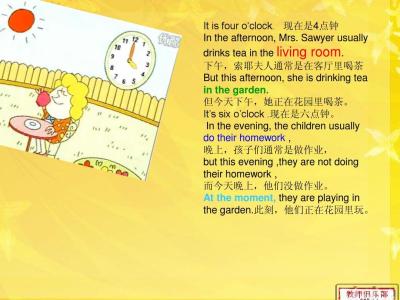
例:It isn’t a fine day, is it? 今天天气不好,是吗?
Yes, it is. 不,很好. No. it isn’t. 是的,天气不好.
Lesson 103 Very、Too与enough的用法
1. very (非常、很),常用于正面肯定态度。eg: These questions are very easy.
2. too(表示过分),常用于否定态度
句型: ① too+形容词(太…) 例:It’s toohot. ② too+形容词+for sb. to do sth.(对某人来说太…而不能…) 例: This question is too difficult for me to answer.
③too…to… (太…而不能…) 例: He is tooyoung to go to school.
3. enough: ①enough+名词 例: We have got enough money. ②形容词/副词+enough 例:This coat is good enough.
多学一手:Enoughis as good as a feast. 知足常乐。
以“辅音+y”结尾的词,变y为i,再加-er, -est
heavy
easy
heaier
easier
heaviest
easiest
闭音节单音节词,末尾只有一个辅音字母,须双写这个辅音字母,再加-er, -est
hot
big
hotter
bigger
hottest
biggest
部分双音节和多音节词,在该形容词前加 more, most
beautiful
difficult
more beautiful
more difficult
most beautiful
most difficult
Lesson 105 (带To的)动词不定式
1.定义: 不定式符号“to”和介词“to”形式相同,但意义和功能不同。
① 不定式符号“to”置于动词之前;
② 介词“to”置于名词,代词或名词短语之前,构成介词短语。
2. 动词不定式(一般式主动语态)肯定句的构成:to+V.(动词)原形
eg: Hewants to buy a car. (不定式) 比较:Pass thesugar to me, please.(介词)
3. 不定式的否定式:not to+动词原形 (在不定式前+not即可)
例:He wants to buy a car.(动词不定式) Pass the ruler to me.(介词)
4. 句型: want sb. to do sth. ; tell sb to do sth; ask sb to do sth.
例:He told me to open the window.
The police asked the children not to playin the street.
原级
比较级
最高级
clever /`klev?/
cleverer /`klev?r?/
cleverest /`klev?rist/
near /ni?/
nearer /`ni?r?/
nearest /`ni?rist/
Lesson 107 形容词的比较等级构成
1. 定义:大多数形容词有比较等级的变化,用来修饰不同的程度,即原级、比较级和最高级。形容词原来的形式称为原级。在表示“较……”和“最……”这样的概念时,要用的形式分别称为形容词的比较级和最高级。
其构成形式见下表:
规则变化
构成法
原级
比较级
最高级
一般情况词尾加-er, -est
tall
long
taller
longer
tallest
longest
单音节词以e结尾只加-r, -st
Fine
Large
finer
larger
finest
largest
形容词原级加-er, -est后的读法:
① 在词尾加-er的形容词比较级,er读作/?:/; 在词尾加-est后,est读作/ist/,常和它前面的音连起来读。
② 如果形容词原级词尾是不发音的字母r,加-er或-est后,r发/r/音
③ 如果形容词原级词末发/?/音,加-er或-est后,/?/音后得加一个/g/音
原级
比较级
最高级
tall /tЭ:l/
taller /`tЭ:l?/
tallest /tЭ:list/
healthy /`helθi/
healthier /`helθi?/
healthiest /helθist/
short /∫Э: t/
shorter /`∫Э:t?/
shortest /`∫Э:tist/
不规则变化
原级
比较级
最高级
strong /strЭ?/
stronger /`strЭ?g?/
strongest /`strЭ?gist/
long /lЭ?/
longer /`lЭ?g?/
longest /`lЭ?gist/
原级
比较级
最高级
good好; well身体好
better
best
bad、ill 坏
worse
worst
many、much许多
more
most
little 少
less
least
far 远
farther further
farthest furthest
old 旧、老
older oldest
oldest eldest
注:elder、eldest不能用于比较等级
例:My elder/eldestsister is a teacher.
表示年长
2. 比较级的用法
在使用比较级时,如需把比较的两项都提到,须在比较级后用“than”(表示二者之间的比较),如果比较级所指的很清楚,它可独立存在。
例: ①The Changjiang River is longer than the Yellow River.
② This book is more/less interesting thanthat one.
③ Which house do you prefer?
I prefer the older one.
注:形容词的比较级可用much等词修饰,表示不定度量。
例:A horse ismuch heavier than a dog.
3. 最高级的用法(三者以上的比较)
① 最高级的限定范围一般用of、among、in等介词短语。
例:He is thetallest in our class.
② 限定范围也可用从句。
例:She is themost beautiful girl I’ve ever seen.
③ 如范围很清楚,则可省略。
例:April isthe best season. (暗含范围“一年中 ”)
Lesson 109 降级比较
用正面的词来表示反面的意思, 则在此正面词前面加less。
expensive(贵) → less expensive(不贵)
developed(发达的) → less developed(不发达)
more than that (比那多) → less than that(比那少)
例句:That book is less expensive than that one.
China is less developed than America.
Lesson 111 同级比较
肯:A is as + adj.原形 + as + B.
Tom is as tall as Jimmy. Tom和Jimmy一样高
否:A isn’t as/so + adj.原形 + as + B.
Tomisn’t so tall as Jimmy. Tom 不和Jimmy一样高。
Lesson113 A的情况也适合B
肯:So + 助/be/情 + B
Tom is a teacher. So is Lily. = Lily is ateacher, too.
Tom can swim. So can Lily. Tom likes singing. So does Lily.
否:Neither + 助/be/情 + B
Tom isn’t a teacher. Neither is Lily. Tom 不是老师,Lily也不是。
Tom can’t swim. Neither can Lily. = Lilycan’t swim, either.
Tom doesn’t like singing. Neither does Lily.
Lesson 115 不定代词的用法
1. 构成:some/any/no/every + one/body/thing
2. 口诀:不定代词做主语,谓语要用三单形式 (除both, all)
如:Every is here.
Everybody wants to have lunch in the garden.
There is none left.
Each of the students has a ticket.
3. 口诀:adj.修饰不定代词要后置
Do you have anything importantto say?
Lesson 117 过去进行时
1. 表示:过去某个时间点正在干的事情
2. 构成:主+was/were+doingsth.
eg: I was watchingTV at 8:00 yesterday evening.
3. 特点:过去进行时与一般过去时经常同时出现在一个句子中,其时间状语从句常用when, while, just as引导。
eg:I was cooking while my husband was watching TV.
When Iwas doing my homework, my mother came in.
He wasleaving out when the telephone rang.
他正要离开突然电话响了。
Lesson119 过去完成时
1. 表示:过去的过去发生的动作。
2. 构成:主+haddone (done 指所有动词的过去分词)
3. 特点:肯定是复合句,两个句子前后是两个动作,一个用一般过去时,另一个用过去完成时(先发生)。
例如:When I got home, the train had left.
After Ihad finished my work, I left.
Lesson 121 定语从句
1. 定义:由一个句子来充当定语称为定语从句。
2. 位置:通常置于它所修饰的名词(n.)或代词(pron.)之后。这种n.或pron.叫作先行词。
3. 引导词:先行词是人,则用who (充当主语) whom (充当宾语)
先行词是物,则用which (主/宾)
例:I lost the book which he lent to me.
以此句为例,book为先行词,which为引导词(手拉手作用、连接作用)。虽然
在定语从句中做宾语成分,但仍要置于主句与从句之间。
例: The manwho is under the tree is my friend, Tom.
(先行词表人可用that替换,主语不能用whom)
He said he isthe man who lost the suitcase.
(先行词表人,可用that、whom代替)
引导词作用:① 连接作用; ② 在定语从句中代替先行词充当一个句子成分。
Lesson 123 定语从句中关系代词的省略
① 先行词在定语从句中充当宾语时,关系代词可省略。
eg: (原句)They are the men who(that)I saw yesterday. (省略)
= They are the men I saw yesterday.
② 当先行词在定语从句中做主语,且当从句的时态为进行时,引导从句的关系代词
和be动词可同时省略。
eg: (原句)The men who are repairing the road make allthat noise. (复合句)
(省略) The men repairing the road make all that noise. (简单句)
Lesson131 情态动词表推测 (过去)
1.表示对现状进行猜测除了must be , can not be (表示对有根据的推论之外),还可用 主+ may be 或 主 +may+V原形(表示一种可能性)
2.对过去发生的事情表示有可能性除must have been , con not have been 外还可用 may have been 例如:①Hemay be tall ,I am not sure .
He may be doing his homework ,I am not sure .
He may go home .
②. He may have been a manager. 萎缩
Lesson 125 must与have to
must
Have to
定义
必须、强调主观必要性
不得不、强调客观情况
性质
情态动词,没有人称、数与时态的变化
含有情态的固定短语,具有have 的各种时态
搭配
must + to
have to/has to do/had to do
变疑
① Must提句首
② 肯定回答 must,否定回答needn’t
① 须根据have具体时态选择助动词
② 用什么提问,用什么回答
变否
① mustn’t表示绝对禁止,不该/不能
② needn’t (直接代替must)表示没必要,等同于not have to
须根据have具体时态选择助动词的否定形式
Lesson127 情态动词表推测 一 (目前/将来)
① 肯定:主 + must be + 表对目前状态的猜测 eg: The man must be Tom.
+ v-ing 对正在进行的动作猜测eg: He must be watching TV.
must may might (减弱)
② 否定:主 + can’t be + +表对目前状态的猜测
+ v-ing对正在进行的动作猜测
eg:The play can’t be wonderful
He can’t be at home now.
can’t may not might not (减弱)
Lesson129 情态动词表推测 二 (过去)
1. 肯定:主 + must have been
have done
eg:They musthave been waiting for the bus then .
They must have gone out.
否定: 主语+ can’t havebeen
have done
eg:They cannot have been waiting for the bus then .
They cannot have gone out.
Lesson 133 –134 需改变时态的间接引语
当主句中的谓语动词如果是过去时态,则间接引语的时态通常要“往回移”。即:口诀:五种时态倒推跑。
移动方法:一般现在时 → 一般过去时 现在进行时 → 过去进行时
现在完成时 → 过去完成时 一般过去时 →过去完成时
一般将来时 → 过去将来时
在时态移动的同时,还要注意人称的变化。
eg:He said, “I am fine.”→ He said (that) he was fine.
She said, “I am havingdinner.”→ He said(that)he was having dinner.
He said, “I havebeen there.”→ He said (that) he had been there.
另:如果直接引语是客观真理,一般现在时则不变。eg:
My teacher said,“The earth goes around the sun.”
→ My teacher saidthat the earth goes around the sun.
Lesson 135 –136 间接引语中情态动词的变化
将直接引语变为间接引语的动词时态倒移过程中,情态动词同样也要相应的变化。
will can won’t can’t may be going to shall
↓ ↓ ↓ ↓ ↓ ↓ ↓
would could wouldn’t couldn’t might would should
eg: He said, “Iwill change some money.” → He said that he would change some money.
Lesson 137 –138 If 引导的条件状语从句
口诀:如果主句是将来时,则if引导的条件状语从句用一般现在时表将来。
eg: If he comes tomorrow. I’ll tell you.
Lesson 139 –140 宾语从句(二)
1. 复习L99课宾语从句(一)
2.宾语从句除了可以由that、who、whom 和 which引导外,还可以由 when、why、what、where、how、if、whether引导。
eg: Idon’t know if you are all right.
Hewants to know what your name is.
Doyou know where the park is?
引导词在从句中充当成分, 有具体意义, 往往不能省略。
口诀:所有的从句都是陈述句式,特别需注意由直接引语变间接引语时的变化。
eg: He asked: “Where will you go?” → Heasked where we would go.
Lesson 141 –142 被动语态(一)
1. 主动:I plant a tree.
被动: A tree isplanted by me.
解释: 主语是物,与动词的关系是被动关系,则选用被动语态。
2. 结构:be + 实义动词过去分词(所有时态都通过be的变化实现)
A: 一般现在时:主 + am/is/are + v.过去分词
eg: I make the bed every day. → The bed ismake by me every day.
B: 一般过去时:主+ was /were+ v.过去分词
eg: The policeman stopped his car. → His carwas stopped by the policeman.
注意:⑴没有必要或不知道动作执行者是谁不用by;
⑵出于礼貌等方面的原因不愿说出动作的执行者可省略by。
被动语态用法:⑴动作执行者未知; ⑵动作执行者无需指出;
⑶强调或侧重动作承受者; ⑷出于礼貌。
Lesson 143 –144 被动语态(二)
现在完成时被动语态: 主+ have/has been + v.过去分词
eg: They have planted those trees. → Thosetrees have been planted.
一般将来时被动语态: 主+ will/shall be + v.过去分词
eg: I will water the garden soon. → Thegarden will be watered soon.
 爱华网
爱华网